Locals rarely make the time to appreciate the grandeur and history of Midtown’s most lavish hotels. That is a shame, as these luxurious buildings are among the architectural jewels of the neighborhood. Given that John Jacob Astor IV, Cary Grant, William Randolph Hearst, and Alfred Vanderbilt deemed them worthy of a stay, these hotels definitely warrant more than a passing glance.
The Algonquin Hotel
59 West 44th Street (between Fifth and Sixth Avenues)
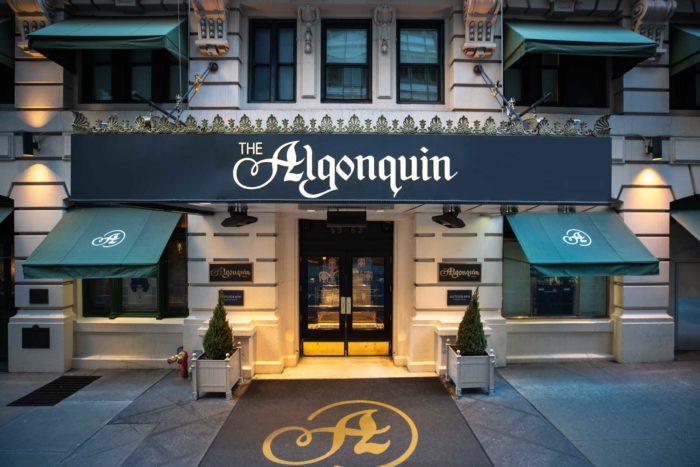
Image: the Algonquin
Despite its rusticated limestone lower facade, red-brick-and-limestone upper floors, and bay windows, the Algonquin is not best known for its good looks. The 12-story hotel was designated a New York City Landmark in large part because of its fabled history. Built in 1902, the Algonquin in 1919 became a regular lunch spot for a group of sharp-witted, sharp-tongued writers and artists who dubbed themselves the Vicious Circle. Once the hotel owner laid a large round top on their table to accommodate the growing group, they became known as the Algonquin Round Table. Dorothy Parker, Robert Benchley, George S. Kaufman, Edna Ferber, and Harpo Marx were among the luminaries who met here almost daily for 10 years. Another member of the group, Harold Ross, conceived of “The New Yorker” magazine here and, lore has it, financed the publication with his poker winnings from other Vicious Circle members. In the 1980s, the hotel became almost as well known for its Oak Room supper club. Harry Connick Jr., Michael Feinstein, and Diana Kroll were among those who launched their careers here before the cabaret closed in 2012. Luxury-lovers may know the hotel for its $10,000 Martini, aka Martini on the Rock, consisting of a martini poured over a diamond from the in-house jeweler (unlike other bar orders, this one must be made at least three days in advance). And feline aficionados will be delighted to hear that since 1923 the Algonquin has had a resident cat. Hamlet VIII, the current cat, is the 11th to be lucky enough to make the hotel its home.
The Knickerbocker
Six Broadway (at 42nd Street)
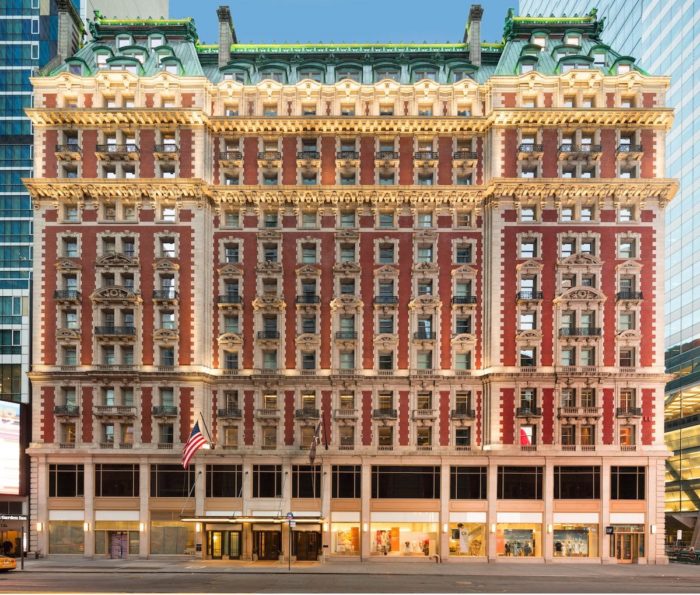
Image: the Knickerbocker
John Jacob Astor IV, who owned the Knickerbocker when it opened in 1906, was one of the world’s richest men. It is estimated that when he died six years later on the “Titanic,” he was worth $87 million, the equivalent of $2.26 billion today. So it is not surprising that the 14-story, 556-room hotel was wildly luxurious. It boasted murals by Maxwell Parrish and Frederic Remington, electric fountains, and a wealth of Beaux-Arts ornamentation, topped with a copper mansard roof. The martini was said to have been invented here in 1912, and legendary opera singer Enrico Caruso was a long-time resident. The Knickerbocker’s original incarnation as a hotel lasted only 15 years; Vincent Astor, the son and heir of John Jacob IV, converted it to an office building in 1921, blaming Prohibition for a downturn in business. From 1940 to 1959 it was better known as the Newsweek Building, after its most famous tenant. In 2015 it reopened as a hotel under the Knickerbocker name with a refurbished interior to appeal to 21st-century guests. The majestic exterior, however, was left intact.
The Lotte New York Palace
455 Madison Avenue (at East 50th Street)
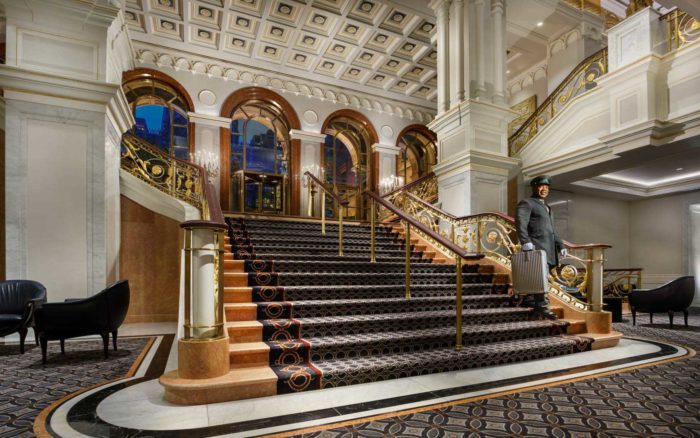
Image: Lotte NY Palace
In many other locales the New York Palace’s 55-story glass skyscraper would command the lion’s share of the attention. Here, though, it is the six Italianate town houses making up the front of the hotel that are the subject of tourist photos. Financier Henry Villard commissioned prestigious architecture firm McKim, Mead & White to design the homes in 1882. Dubbed the Villard Houses, they were inspired by Rome’s Renaissance Palazzo della Cancelleria and built around a carriage entrance that is now the courtyard leading to the hotel entry. The houses did not become a hotel until 1981, seven years after developer Harry Helmsley proposed building the adjoining glass tower. Helmsley and his wife, Leona, owned and ran the Palace until 1992; during that time Leona was so notorious for her harsh treatment of the staff—and of vendors and contractors as well—that she became known as the Queen of Mean.
The Peninsula
700 Fifth Avenue (at 55th Street)
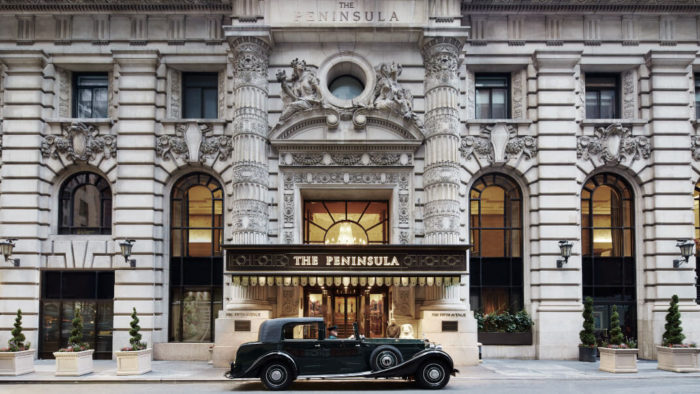
Image: The Peninsula Exterior New York
When it opened in 1905, the Peninsula—or as it was then named, the Gotham—was one of the city’s first hotels to be built with a steel frame. Though its highly decorated limestone-and-granite exterior, double-height dining room, and grand marble staircase seem ornate by today’s standards, at the time the Gotham was considered sedate in comparison with nearby rivals the Plaza and the St. Regis. The Gotham went bankrupt after just three years, because it was denied a liquor license for being within 200 feet of a church—in this case, the Fifth Avenue Presbyterian Church. The 23-story building passed through a series of owners in the following decades until its current owner, the Peninsula hotel group, bought it in 1988; in 1999 it spent $45 million on renovations. The law regarding the selling of liquor in proximity to churches still stands, by the way, but now the distance is measured from the liquor’s actual point of sale. That is why a flight of stairs and a long hallway separate the Peninsula’s cocktail lounge from the lobby.
The Plaza
768 Fifth Avenue (at Central Park South)
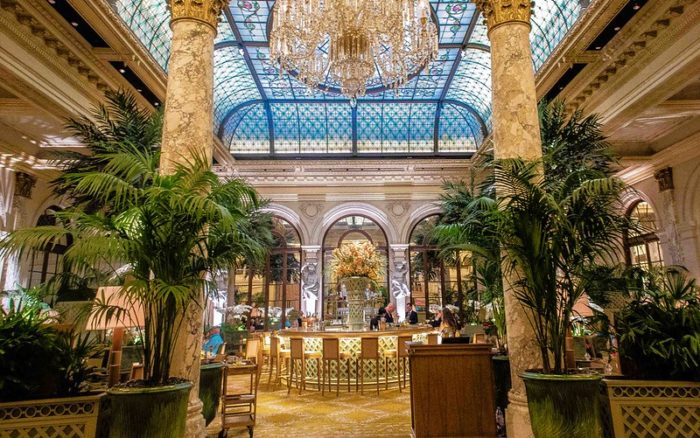
Image: Rajiv Bhuttan/Flickr
To understand why what is now the Peninsula was considered understated, you need only visit the Plaza four blocks away. Designed in 1905 by Henry Janeway Hardenbergh, the architect responsible for the Upper West Side’s Dakota apartments, the Plaza cost $12.5 million, equivalent to more than $352 million today, after running wildly over budget. Inspired by the opulence of French châteaus, the 282-room hotel boasted 1,650 crystal chandeliers and Mr. and Mrs. Alfred Vanderbilt as its first guests in 1907. In subsequent decades John Coltrane, Marlene Dietrich, Duke Ellington, Billie Holiday, Bob Hope, Peggy Lee, and Liza Minnelli played at its Persian Room nightclub, since reborn as the Rose Club; Miles Davis even recorded a live album there in 1958. Frank Lloyd Wright lived in the Plaza for five years in the 1950s, the Beatles stayed here during their initial American tour in 1964, and Truman Capote held his acclaimed Black and White Ball here in 1966. Perhaps the Plaza’s most famous guest, however, is a fictional one: Eloise, a rather obstreperous little girl who lives on the top floor with her nanny. Kay Thompson, who played the Persian Room and at one time lived in the Plaza, wrote four best-selling children’s books about Eloise, the first of which was published in 1955.
The Roosevelt Hotel
45 East 45th Street (at Madison Avenue)
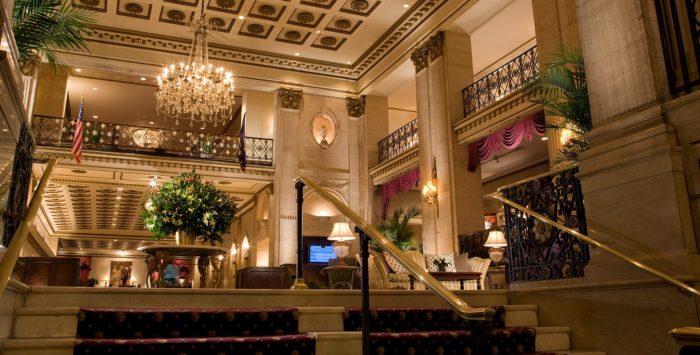
Image: the Roosevelt Hotel
Built in 1924, the Roosevelt Hotel lays claim to many firsts: It was the first New York hotel to have stores rather than lounges and bars opening onto the street (due to Prohibition). It was the first to have an on-premises doctor, a health club, a facility for guests’ pets, and radios, then TVs, in every one of its 1,015 guest rooms and suites. The so-called Grande Dame of Madison is as luxe as it is large, with six-foot-high sconces, a ceiling mural in its two-story Palm Room restaurant, stained-glass windows in its Madison Club Lounge, and an ornate pendant clock in its lobby.
The St. Regis New York
Two East 55th Street (at Fifth Avenue)
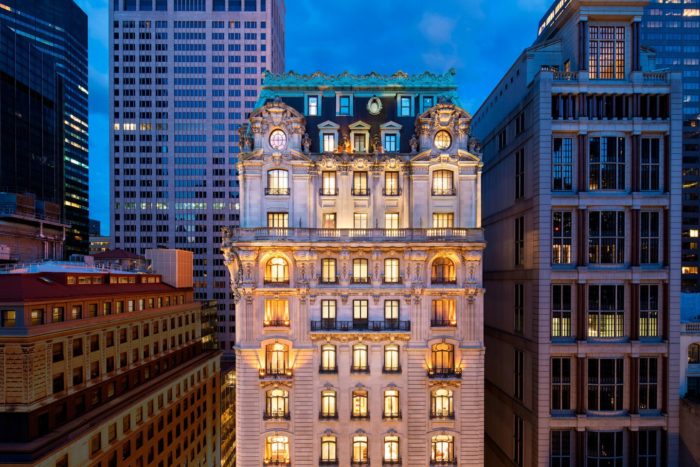
Image: the St. Regis New York
The Knickerbocker was not John Jacob Astor IV’s first foray into the hotel business. He also owned the St. Regis, which opened in 1904. At the time the 18-story Beaux-Arts building was the city’s tallest hotel. The architectural firm responsible for its elaborate design, Trowbridge & Livingston, later designed the Knickerbocker, the Hayden Planetarium, and the Oregon State Capitol. Marble for the floors was imported from Caen, France; the crystal chandeliers were made by Waterford; the library was filled with 3,000 leather-bound books; and unusually for the time, every room had its own telephone. In all, Astor spent $5.5 million on the hotel—the equivalent of more than $155 million today. One of the hotel’s best-known features was not original to the hotel, however. The “Old King Cole” mural by Maxfield Parrish, commissioned for the Knickerbocker, was relocated to the bar of the St. Regis in 1932; in 1948 the refurbished lounge was named King Cole Bar in its honor. Before the renaming, though, in 1934, a bartender at the St. Regis invented a cocktail made with vodka, tomato juice, horseradish, and other ingredients that he called the Red Snapper; today it is better known as the Bloody Mary.
The Warwick
65 West 54th Street (between Fifth and Sixth Avenues)
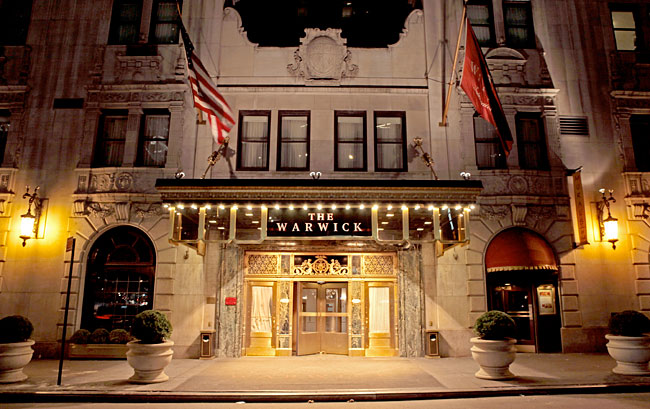
Image: The Warwick NY/inboundDestinations.com
Some people shower their lovers with gemstones. While magnate William Randolph Hearst no doubt did so for his longtime paramour, actress Marion Davies, he also built her the Warwick so that she had a place to live—and he a place to stay—in Manhattan. The penthouse of the 36-story hotel was designed especially for her. Now, though, it is referred to as the Cary Grant Suite, as the actor resided here from 1950 to 1962, long after Davies’s 1937 retirement from acting, at which point she abandoned New York for Hearst’s San Simeon, CA, estate. Opened in 1926, the hotel is Renaissance Revival in style, with the facade of the first three floors clad in limestone and granite, topped by the remaining red-brick stories. Unlike other grand hotels of the period, the Warwick has a fairly small lobby; Hearst requested this so that fans and paparazzi would not camp out here for a glimpse of Davies or their glitterati friends.
Grand Hotels Midtown


